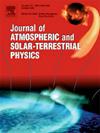2024年10月10-11日极强磁暴期间电离层电流活动的行星特征
IF 1.9
4区 地球科学
Q3 GEOCHEMISTRY & GEOPHYSICS
Journal of Atmospheric and Solar-Terrestrial Physics
Pub Date : 2025-09-12
DOI:10.1016/j.jastp.2025.106631
引用次数: 0
摘要
电离层E区的一个重要特征是水平向西和向东的电流(电喷流),在地面上观测到的磁场特征是磁场h分量的负和正海湾。电喷流在磁暴期间显著增强。2024年10月10-11日的磁暴(Dstmin =−335 nT)是第25个太阳周期中最强的磁暴之一。在太阳风动压极高(Psw)达到~ 40 nPa的风暴主阶段,观察到IMF By和Bz强度的大变化(从+40 nT到- 40 nT)。本文利用amere项目66颗LEO卫星的磁场测量数据绘制的全球地图,研究了电离层电喷流配置的行星特征。研究结果表明,电离层电喷流和相应的场向电流(FAC)特征与行星际磁场(IMF)的IMF By和Bz分量的符号和值以及太阳风动压(Psw)有很强的相关性。研究还表明,IMF的标志强烈地控制着接近磁午时的日侧极电喷流的方向和观测区域的宽度。结果表明,在强磁暴期间,电离层电喷流的行星状态取决于行星际空间的状态。本文章由计算机程序翻译,如有差异,请以英文原文为准。
Planetary feature of the ionospheric current activity during 10–11 October 2024 extremely strong magnetic storm
One important feature of the ionosphere E region represents the horizontal westward and eastward electric currents (electrojets) which magnetic signature is observed on the ground as negative and positive bays in the H-component of the magnetic field. The electrojets significantly enhance during magnetic storms. The magnetic storm on 10–11 October 2024 (Dstmin = −335 nT) was one of the strongest storms in the present 25th solar cycle. Large variations in the intensity of the IMF By and Bz (from +40 nT to −40 nT) were observed during the main phase of the storm at the very high solar wind dynamic pressure (Psw) up to ∼ 40 nPa. Here we present the planetary features of the configuration of the ionosphere electrojets, which were studied by applying the global maps based on the magnetic measurements on 66 LEO satellites of the AMPERE project. The results of our study demonstrated the strong dependence of the ionospheric electrojets and correspondent field-aligned current (FAC) features on the sign and values on the IMF By and Bz components of the Interplanetary Magnetic field (IMF) as well as on the solar wind dynamic pressure (Psw). It was shown also that the sign of the IMF By strongly controls the direction of the dayside polar electrojet near magnetic noon and the width of the region where it is observed. It was concluded that during a strong magnetic storm, the planetary state of the ionospheric electrojets depends on state of the interplanetary space.
求助全文
通过发布文献求助,成功后即可免费获取论文全文。
去求助
来源期刊

Journal of Atmospheric and Solar-Terrestrial Physics
地学-地球化学与地球物理
CiteScore
4.10
自引率
5.30%
发文量
95
审稿时长
6 months
期刊介绍:
The Journal of Atmospheric and Solar-Terrestrial Physics (JASTP) is an international journal concerned with the inter-disciplinary science of the Earth''s atmospheric and space environment, especially the highly varied and highly variable physical phenomena that occur in this natural laboratory and the processes that couple them.
The journal covers the physical processes operating in the troposphere, stratosphere, mesosphere, thermosphere, ionosphere, magnetosphere, the Sun, interplanetary medium, and heliosphere. Phenomena occurring in other "spheres", solar influences on climate, and supporting laboratory measurements are also considered. The journal deals especially with the coupling between the different regions.
Solar flares, coronal mass ejections, and other energetic events on the Sun create interesting and important perturbations in the near-Earth space environment. The physics of such "space weather" is central to the Journal of Atmospheric and Solar-Terrestrial Physics and the journal welcomes papers that lead in the direction of a predictive understanding of the coupled system. Regarding the upper atmosphere, the subjects of aeronomy, geomagnetism and geoelectricity, auroral phenomena, radio wave propagation, and plasma instabilities, are examples within the broad field of solar-terrestrial physics which emphasise the energy exchange between the solar wind, the magnetospheric and ionospheric plasmas, and the neutral gas. In the lower atmosphere, topics covered range from mesoscale to global scale dynamics, to atmospheric electricity, lightning and its effects, and to anthropogenic changes.
 求助内容:
求助内容: 应助结果提醒方式:
应助结果提醒方式:


